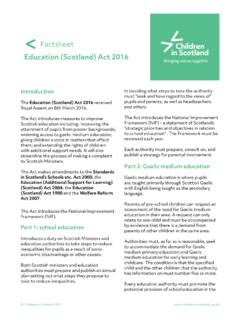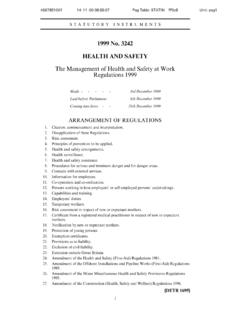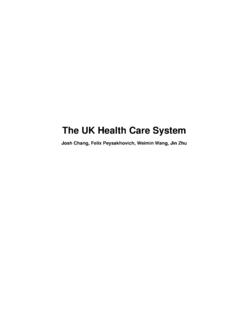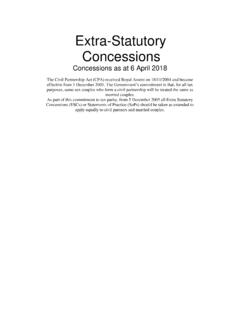Transcription of The Equality Act 2010 and schools - GOV.UK
1 The Equality Act 2010 and schools Departmental advice for school leaders, school staff, governing bodies and local authorities May 2014 2 Contents Summary 5 Chapter 1 Overview of the Act 7 schools : who and what the Act applies to 7 Protected characteristics 8 Association 8 Perception 8 Unlawful behaviour 9 Special provisions for disability 11 Definition of parents 11 Further Information 11 Chapter 2 - General exceptions 12 Single sex schools 12 schools with a religious character 12 Admissions 12 Benefits facilities and services 13 What is not permissible 13 Curriculum 14 Acts of worship 15 Uniforms 15 Bullying 16 schools duty of care 16 Chapter 3 Special issues for some protected characteristics 17 Gender reassignment 17 Race 18 3 Segregating pupils by race or ethnicity 18 Religion or belief 19 Sex/gender 20 Single sex classes 20 Single sex sport 20 Pregnancy and maternity 21 Sexual orientation and marriage and civil partnership 22 Sexual orientation and religion or belief 22 Chapter 4 - Disability 24 Provisions relating
2 To disability 24 Definition of disability 25 Unlawful behaviour with regard to disabled pupils 25 Reasonable adjustments and when they have to be made 26 Auxiliary aids and services 26 Making reasonable adjustments 27 schools duties around accessibility for disabled pupils 29 Local authorities duties around accessibility for disabled pupils 29 Chapter 5 - The Public Sector Equality Duty 30 Having due regard 31 What compliance with the specific duties will mean for schools 31 Publishing information 33 Eliminating discrimination and other conduct that is prohibited by the Act 33 Advancing Equality of opportunity between people who share a protected characteristic and people who do not share it 33 Engagement 35 How to publish information 35 4 Equality objectives 35 DfE compliance with the PSED 36 Chapter 6 - Local authorities and education functions 37 Establishment and closure of schools 37 School curriculum 37 School admissions 37 School transport 38 Acts of worship 38 Reasonable adjustments for disabled pupils 38 Chapter 7 How the Act is enforced 39 Discrimination claims court proceedings 39 Discrimination claims tribunal proceedings for disability cases 39 Burden of proof 40 The Questions Procedure 40 Chapter 8 education specific employment provisions 41 What the Act covers 41 Reasonable adjustments 41 Enquiries about health and disability 42 Employment exceptions for schools with a religious character 42 Voluntary-controlled and foundation schools with a religious character 43 VC/foundation schools with a religious character becoming academies 43 Voluntary-aided schools , independent schools .
3 Academies and free schools with a religious character 44 5 Summary About this departmental advice This is non-statutory advice from the Department for education . It has been produced to help schools to understand how the Equality Act affects them and how to fulfil their duties under the Act. It has been updated to include information on same-sex marriage. On 1 October 2010 , the Equality Act 2010 replaced all existing Equality legislation such as the Race Relations Act, Disability Discrimination Act and Sex Discrimination Act. It has consolidated this legislation and also provides some changes that schools need to be aware of. Expiry/review date Current version dated May 2014. This advice will next be reviewed before April 2016. Who is this advice for? This advice is for school leaders, school staff and governing bodies in maintained schools and academies but may also be useful for local authorities and parents.
4 Key points The Equality Act 2010 provides a single, consolidated source of discrimination law. It simplifies the law and it extends protection from discrimination in some areas. As far as schools are concerned, for the most part, the effect of the current law is the same as it has been in the past meaning that schools cannot unlawfully discriminate against pupils because of their sex, race, disability, religion or belief or sexual orientation. The exceptions to the discrimination provisions for schools are all replicated in the current act such as the content of the curriculum, collective worship and admissions to single sex schools and schools of a religious character. schools that were already complying with previous Equality legislation should not find major differences in what they need to do. However, there are some changes that will have an impact on schools as follows: Protection in schools Protection against discrimination is now extended to pupils who are pregnant or have recently given birth, or who are undergoing gender reassignment.
5 6 Health related questions for job applicants It is now unlawful for employers to ask health-related questions of applicants before job offer, unless the questions are specifically related to an intrinsic function of the work. This means that schools should no longer, as a matter of course, require job applicants to complete a generic health questionnaire as part of the application procedure. There are potential implications in relation to establishing teachers fitness and ability to teach (as required by the Health Standards (England) Regulations 2003). schools are advised to review their existing practices to ensure they are complying with both the Health Standards Regulations and Section 60 of the Equality Act. schools may decide to ask necessary health questions after job offer. In any case, they should ensure that any health-related questions are targeted, necessary and relevant to the job applied for.
6 Positive Action Positive Action provisions allow schools to target measures that are designed to alleviate disadvantages experienced by, or to meet the particular needs of, pupils with particular protected characteristics. Such measures will need to be a proportionate way of achieving the relevant aim. Previously a school providing for example - special catch-up classes for Roma children or a project to engage specifically with alienated Asian boys might have been discriminating unlawfully by excluding children who didn t belong to these groups. Victimisation It is now unlawful to victimise a child for anything done in relation to the Act by their parent or sibling. Auxiliary aids The Act extends the reasonable adjustment duty to require schools to provide auxiliary aids and services to disabled pupils. Following consultation on implementation and approach, the duty came into force on 1 September 2012.
7 Equality duties The three previous general and specific Equality duties on schools (race, disability and gender) to eliminate discrimination and advance Equality of opportunity have been combined into a less bureaucratic and more outcome-focused duties covering an expanded number of protected characteristics. The general duty, public sector Equality duty, is explained in chapter 5 of this advice. As is the lighter touch specific duty. These are the provisions of the Act but schools will need to be aware of how the rest of the Equality Act applies to them. This is set out below. 7 Chapter 1 Overview of the Act The Equality Act 2010 replaced nine major Acts of Parliament and almost a hundred sets of regulations which had been introduced over several decades. It provides a single, consolidated source of discrimination law, covering all the types of discrimination that are unlawful.
8 It simplifies the law by getting rid of anomalies and inconsistencies that had developed over time, and it extends protection against discrimination in certain areas. As far as schools are concerned there are some changes, which this guidance will explain, but for the most part the effect of the law is the same as it has been in the past schools which are already complying with the law will not find major differences in what they need to do. In some areas in particular the introduction of the public sector Equality duty which has replaced the three separate duties on race, disability and gender the overall effect of the Act will be to reduce a certain amount of bureaucracy and so should be less burdensome and more effective. schools : who and what the Act applies to In England and Wales the Act applies to all maintained and independent schools , including Academies, and maintained and non-maintained special schools .
9 In scotland it applies to schools managed by education authorities, independent schools and schools receiving grants under section 73(c) or (d) of the education ( scotland ) Act 1980 . The Act makes it unlawful for the responsible body of a school to discriminate against, harass or victimise a pupil or potential pupil: in relation to admissions, in the way it provides education for pupils, in the way it provides pupils access to any benefit, facility or service, or by excluding a pupil or subjecting them to any other detriment. The responsible body is the governing body or the local authority for maintained schools in England and Wales, the education authority in the case of maintained schools in scotland , and the proprietor in the case of independent schools , Academies or non-maintained special schools . In practice, any persons acting on behalf of the responsible body including employees of the school are liable for their own discriminatory actions, and the responsible body is also liable unless it can show that it has taken all reasonable steps to stop the individual from doing the discriminatory action or from doing anything of that kind.
10 8 The Act deals with the way in which schools treat their pupils and prospective pupils: the relationship between one pupil and another is not within its scope. It does not therefore bear directly on such issues as racist or homophobic bullying by pupils. However, if a school treats bullying which relates to a protected ground less seriously than other forms of bullying for example dismissing complaints of homophobic bullying or failing to protect a transgender pupil against bullying by classmates then it may be guilty of unlawful discrimination. The school s liability not to discriminate, harass or victimise does not end when a pupil has left the school, but will apply to subsequent actions connected to the previous relationship between school and pupil, such as the provision of references on former pupils or access to old pupils communications and activities.














